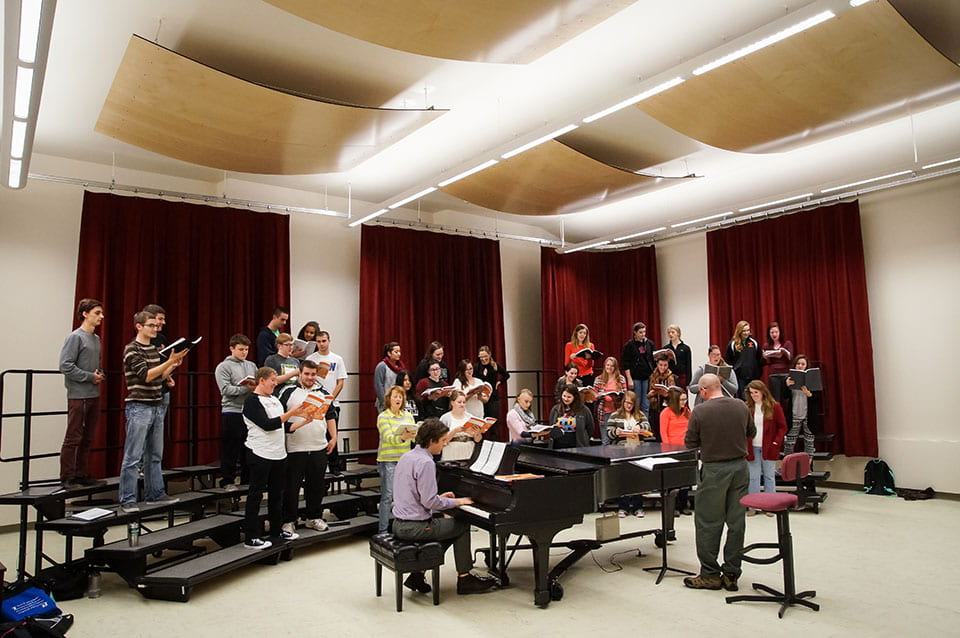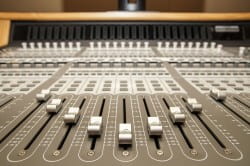Singing the praises of the Studio Arts remodel

State-of-the-art rehearsal, recording studio space is a campus and community asset
Ask Professors Randy Meder and Kevin Collins about the recent upgrades to the rehearsal space within the UW-Green Bay Music program and they’re likely to respond in song. That’s how good the new acoustics are.
Renovations in the Studio Arts building, including a high-tech expansion, places UW-Green Bay at the top of the list for those seeking musical genius. In fact, the energy is palpable when speaking with the professors about their updated space. “Every time they (students) make a sound, their educational experience is enhanced,” says Collins.
Recent physical updates include: instrumental rehearsal space, addition of a state-of-the-art digital recording studio and isolation booth, and enhancement of the number and quality of instruments and existing practice rooms, make UW-Green Bay’s music facility one of the most advanced in the region.
After securing a grant to improve technology and update their facilities to become more environmentally-friendly, the department got to work. “The acoustics were terrible, and it was very difficult to hear each other,” said Collins, describing the instrumental practice rooms — one designated for choral rehearsal and the other for band and orchestra rehearsal. Flat walls, noisy air-handling units and an inefficient sound barrier between rooms had diminished the effectiveness of the rehearsal space, built in 1973. Acousticians from the Chicago area were hired to improve the space — its first update in the history of the program — by creating un-parallel surfaces, slanting walls and by adding wood ceiling panels with beautiful, reflective surfaces. Updates have created a space where students can hear each other more clearly and sound bleed-through between rooms has been reduced by 70 percent.
Recording Studio Redux
 The program’s recording studio also needed to be updated and moved, as it wasn’t Americans with Disabilities Act (ADA) accessible. The new room includes the latest in high-tech, industry-standard digital recording equipment, Pro Tools HD, and allows students and staff to bring unlimited creativity into their recordings. “The software allows students to collaborate on campus, and over the internet — anywhere in the world — in real time,” says Collins.
The program’s recording studio also needed to be updated and moved, as it wasn’t Americans with Disabilities Act (ADA) accessible. The new room includes the latest in high-tech, industry-standard digital recording equipment, Pro Tools HD, and allows students and staff to bring unlimited creativity into their recordings. “The software allows students to collaborate on campus, and over the internet — anywhere in the world — in real time,” says Collins.
An isolation booth, providing a dead acoustical environment with a direct link to the new recording studio, was also added in the space redesign. Rehearsal rooms tie into the recording studio as well through a video camera and Ethernet connection. “Theoretically, we can record from any room on campus,” says Assistant Prof. Bill Sallak. “It’s a really exciting opportunity. As the recording program grows, we won’t have to deal with ripping out drywall and running cable; we can talk about repurposing rooms to think of them as extensions of the recording program.”
This is great news for the University’s music program in a time when music and the fine arts in schools are feeling a crunch. Not here. “Our administration is so supportive, “says Collins, “and it’s a cultural thing and starts at the top. Our previous chancellor was extremely supportive, and our current chancellor keeps it a priority.”
A Musical Resource for Campus and Community
Students involved in the music program aren’t the only ones benefitting from the new and improved digital recording technology. Plans to collaborate with other majors, such as theatre, graphic design and marketing are already in progress. The faculty is committed to fully utilizing this technology to enhance student knowledge and experience within the music program, across other disciplines and within the community.
“We’re now able to teach at an advanced level,” says Meder, citing the music technology systems class that has learned the basics of audio and live recording techniques. The program will expand to include a full emphasis on recording technology and an added benefit to other majors within the music program. “Northeast Wisconsin Technical College has a recording technology program that provides a two-year degree,” says Meder, “we’d love those students to continue their degree here, and give them access while still at NWTC.” A string instrument program will also begin next semester — something the department hasn’t been able to offer for many years.
The program’s highly regarded summer music camps can also be taken to a whole new level.
“Kids are doing amazing things on YouTube…super, high-quality stuff,” says Collins. “We take the training wheels off and give them the tools to hit the ground running and they can do amazing things.”
The community-based Green Bay Civic Symphony rehearses at the University on a regular basis, and now their experience is immeasurably enhanced. “It’s so much better from a hearing perspective,” says Seong-Kyung Graham, conductor with the Civic Symphony. “We’ve been very, very grateful to the University that we are able to use the facility.” She says the strength of the local cultural music scene is a direct result of having a university that hosts such a strong music program. “I feel like there is a special bond and support in the community, especially considering its size.” says Graham. “They help us to be a better ensemble.”
“This is an exciting time to be in the arts,” says Collins. “The need now is for scholarships to bring in those kids who otherwise wouldn’t have access to updated technology and instruments. Now we are able to give students the highest level of quality technology, that they would never be able to afford otherwise.”
— Story by freelance writer Kristin Bouchard ’93




